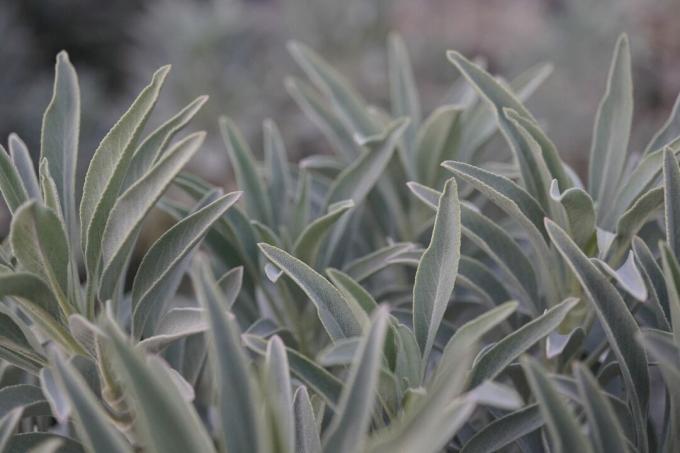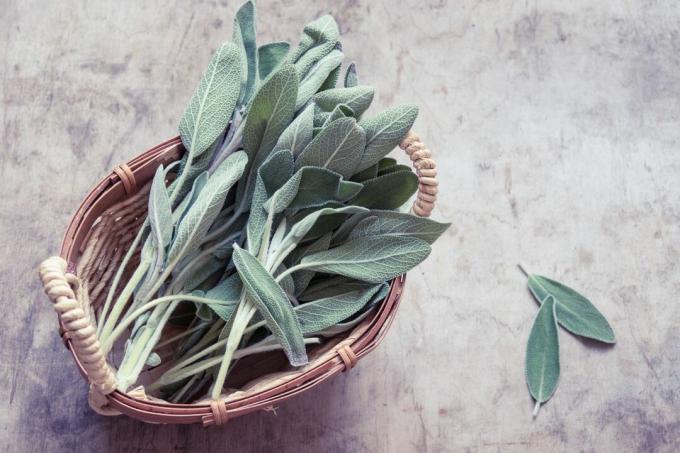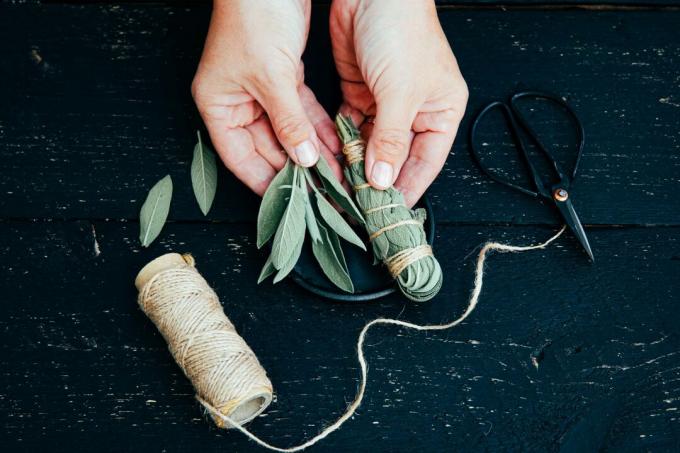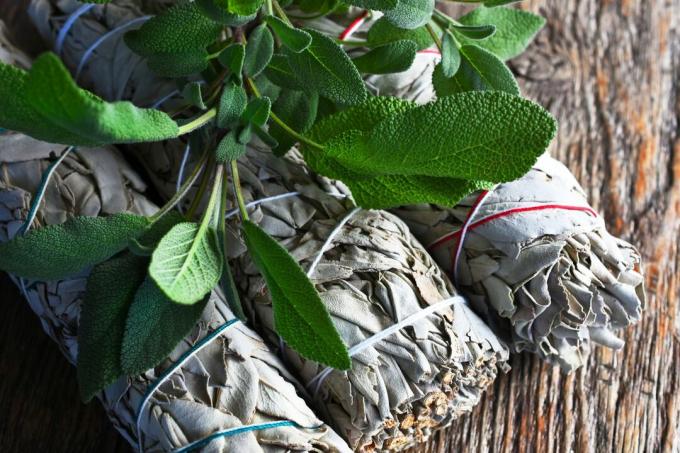The white sage is considered a medicinal plant and is mainly used in incense rituals. This species of sage, which comes from Mexico, is cultivated as a potted plant and also has a disinfecting effect.

The White Sage (Salvia apiana) was already used by indigenous peoples of North America for traditional incense rituals. Today it is also popular because of its disinfecting effect. In the following article we present the intensely fragrant medicinal plant in more detail.
contents
- White sage: origin and properties
-
Plant white sage
- sowing
- Propagation via cuttings
-
The right care
- Water and fertilize
- Cut smoked sage
- Is White Sage Hardy?
- Uses and Effects of White Sage
White sage: origin and properties
The White Sage (Salvia apiana) is also known under the names Indian sage or smoked sage and belongs to the mint family (Lamiaceae). It is valid like the common sage (Salvia officinalis) as a medicinal plant and is native to northwestern Mexico and southwestern United States. Smoked sage is now widespread all over the world.
The evergreen, perennial, mostly herbaceous plant grows as a subshrub and can reach a height of 1.3 m. The 4 to 8 cm long leaves are lanceolate and densely covered with white hairs, strictly speaking trichomes, which give the plant its name. The bizarrely shaped flowers grow in panicles on the erect, reddish-brown stems. The sage flowers are white to purple and the flowering period extends from May to June. The flowers also attract numerous insects, especially honey bees and carpenter bees find the white-lipped flowers very attractive. The intensely fragrant plant sap exudes a tart, resinous smell, which is why the plant is often used for incense.
The white sage, which we mainly cultivate as a container plant, is not hardy and must therefore be protected from frost.

What is the difference between white sage andreal sage? Botanically include the white sage (Salvia apiana) and the common sage (Salvia officinalis) to the same genus (Salvia). The ingredients of the two plants are also comparable, as both contain tannins, bitter substances, flavonoids, resins and essential oils. The main difference lies in the use of the two types. While common sage is often used in the kitchen, white sage is more common in incense rituals and as an aromatic plant. This is because the white sage exudes an even more intense, tart and resinous scent. Another distinguishing feature is the leaves. The hairless and mostly green leaves of the common sage can be easily distinguished from the whitish-green leaves of the white sage. Furthermore, the real sage is significantly harder than the white sage and drives in most cases in the Spring out from its old woody stems while protecting the white sage from frost got to. In addition to real sage and white sage, there are many more sage species for use in the kitchen, as a medicinal plant or as an ornamental plant in the garden.

Plant white sage
The optimal location for white sage is full sun. As it is not hardy in temperate climates, it must be cultivated in a pot. A well-drained, lean, sandy substrate is used for this. Too wet conditions and waterlogging must be avoided.
When planting white sage, it is important to choose a pot of sufficient size, as it is very vigorous. The pot should be at least a third larger than the root ball of the plant. In the long term, a wide bucket with a volume of at least 25 liters is required. Ours is a suitable substrate, for example Plantura organic universal soil. Mixing a third of sand into the soil provides sufficient nutrients for plant growth and at the same time provides a loose and permeable substrate for plant roots. In addition, it is necessary to install a drainage layer of potsherds in the lower part of the pot to avoid waterlogging. The root ball of the plant is buried in the planting hole, pressed down and watered. Young specimens in particular grow better in warmer conditions.

Plantura organic universal soil
Organic, peat-free & climate-friendly:
For all plants indoors & outdoors,
100% natural ingredients,
harmless to humans and animals
sowing
at Salvia apiana it is one light germinator. That means it needs light to start germination. To prepare for sowing, a flat dish is filled with our Plantura Organic Herb & Seed Soil filled. Then the seeds of the white sage are sown on the soil surface and lightly pressed. It is important that there is sufficient water for the seeds to germinate, but that the soil is not soaked wet. The seeds germinate within 2 to 3 weeks at 20 to 30 °C.
Propagation via cuttings
Another option is propagation by cuttings. For this purpose, young, non-flowering and non-lignified parts of the plant are cut off in a length of 8 to 10 cm in spring or early summer. Then remove all pairs of leaves except for the 2 uppermost ones and press the cutting so deep into the substrate that the leaves are still sticking out of the substrate. In light shade, with regular moistening and at temperatures around 12 °C, the cuttings will root as spring progresses. Our cuttings substrate, for example, is suitable Plantura Organic Herb & Seed Soil, which offers optimal conditions for root development due to its lack of nutrients.

The right care
With the right care of the white sage, the plant quickly grows into a fragrant addition to your garden.
Water and fertilize
Since the smoked sage is used to dry conditions in its homeland, it should only be watered moderately. Do not let the soil dry out completely and avoid waterlogging.
When growing in pots, it is advisable to use a primarily organic liquid fertilizer, such as ours, every 2 months during the growing season Plantura organic indoor and green plant fertilizer admit. You should avoid an excessive supply or mineral fertilization, because this would be at the expense of the aroma. When repotting your white sage, you can do a reserve fertilization with an organic slow-release fertilizer like ours Plantura organic flower fertilizer on the bottom of the pot.

Plantura organic indoor and green plant fertilizer
Highly effective organic liquid fertilizer
with a NK ratio of 3-4
for all indoor and green plants,
safe for pets and garden animals
Cut smoked sage
The smoked sage can be cut back in spring. It is important not to cut the woody shoots, but only the herbaceous ones. This allows it to sprout more vigorously and grow more compactly. After flowering, you can prune it again if you wish to provoke a second flowering. The last cut of the ornamental shrub should be done in mid-August.
Tip: Repotting is only necessary when the pot is firmly rooted everywhere. Choosing soil that is structurally stable for a long time and mostly rocky is the best choice in the long term. Because it does not sag and can therefore extend the time between repotting.
Is White Sage Hardy?
In this country, the white sage is not hardy and must therefore be protected from extreme cold and frost. The optimal location for overwintering is a bright, cool but frost-free room with a temperature of 1 to 10 °C. In addition, the pot should be insulated with foil and stored off the ground. The white sage survives light frost down to -2 °C for a short time even without protection.
Tip: It can happen that the white sage is attacked by lice in the winter quarters. A meticulous examination before hibernation and during hibernation helps against this. You can against aphids, for example, our Plantura Organic Pest Free Neem bring to use. The spray works quickly, even catches hidden aphids and is then quickly broken down to protect the environment.

Uses and Effects of White Sage
Even the indigenous peoples of North America used white sage for traditional incense rituals. White sage has a healing effect and helps against respiratory diseases such as coughs and colds. When smoking, the dry leaves of the white sage are tied into so-called "smudge sticks" and set on fire. Smoking with white sage has an antibacterial and disinfecting effect, which is why it is often used for house cleaning. It not only improves the room climate, but also has a positive effect on the ability to concentrate and brightens the mood. It is said that white sage smoke clears negative energies, making room for new things. Another application is as a cleansing infusion in sweat lodges.

Is white sage edible? In general, the white sage plant is edible, but may only be consumed in small quantities because it contains the weak toxin thujone. Pregnant and breastfeeding women in particular should not consume or smoke white sage. The fragrant leaves and flowers are used to flavor various dishes, and the seeds can also be eaten raw or cooked.
The white sage is a beautiful ornamental plant that enriches our garden with a wonderfully intense and resinous scent. It also creates a pleasant atmosphere indoors. Further air-purifying plants can be found in our special article.
...and receive concentrated plant knowledge and inspiration directly in your e-mail inbox every Sunday!



